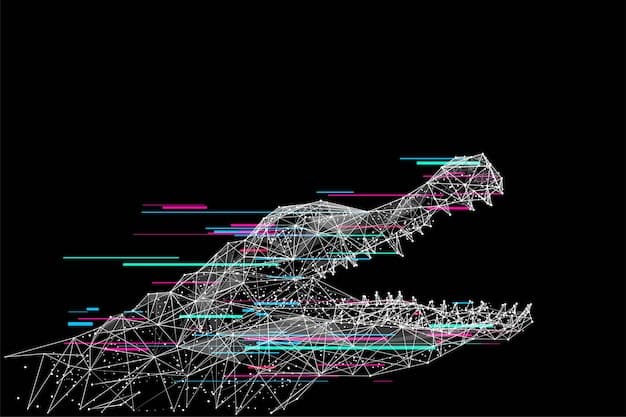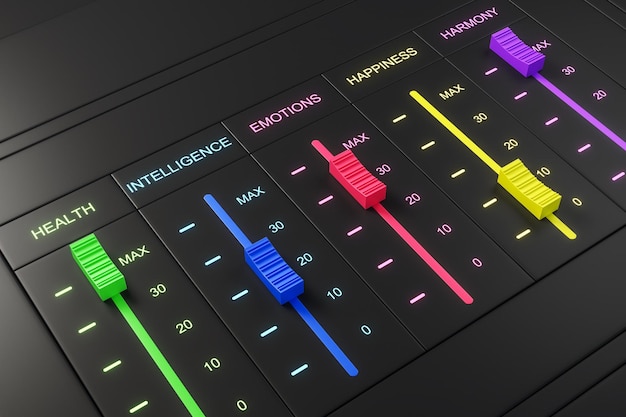Boost Customer Retention: Machine Learning for Churn Prediction

Improving customer churn prediction by 20% using machine learning techniques involves leveraging data analysis, predictive modeling, and targeted interventions to identify and mitigate factors leading to customer attrition, ultimately enhancing customer retention strategies.
Are you struggling with high customer churn rates? Discover how improving customer churn prediction by 20% using machine learning techniques can revolutionize your retention strategy. By identifying at-risk customers before they leave, you can implement targeted interventions to keep them engaged and loyal.
Understanding Customer Churn and Its Impact
Customer churn, also known as customer attrition, refers to the rate at which customers stop doing business with a company. High churn rates can significantly impact revenue, profitability, and brand reputation. Understanding the drivers of churn is the first step in mitigating its effects.
By accurately predicting which customers are likely to churn, businesses can proactively address their concerns and offer personalized solutions. This approach not only reduces churn but also enhances customer satisfaction and loyalty.

The Cost of Customer Churn
Losing customers is costly. Acquiring new customers is often more expensive than retaining existing ones. Furthermore, churn can lead to negative word-of-mouth and damage a company’s reputation. Understanding these costs is crucial for justifying investments in churn reduction strategies.
- Reduced Revenue: Churn directly impacts revenue as fewer customers translate to less income.
- Increased Acquisition Costs: Replacing lost customers requires significant investment in marketing and sales efforts.
- Damaged Reputation: Customers who churn may share negative experiences, affecting brand perception.
Identifying Key Churn Factors
Many factors can lead to customer churn, from poor customer service to competitive offerings. Identifying these factors is essential for developing effective churn prediction models. Data analysis can reveal patterns and trends that highlight potential churn drivers.
- Poor Customer Service: Negative experiences with support can drive customers away.
- Competitive Offers: Better deals from competitors can entice customers to switch.
- Lack of Engagement: Customers who don’t actively use a product or service are more likely to churn.
- Pricing Issues: High prices or unexpected fees can lead to dissatisfaction and churn.
In conclusion, understanding the impact of customer churn and its underlying factors is crucial for developing effective prediction and prevention strategies. Accurate prediction allows businesses to proactively address customer concerns, reduce attrition, and improve overall customer satisfaction.
Machine Learning Techniques for Churn Prediction
Machine learning offers powerful tools for predicting customer churn. By analyzing vast amounts of data, these techniques can identify patterns and predict which customers are most likely to churn. Several machine learning algorithms are particularly well-suited for this task.
These algorithms can process complex relationships between variables and provide accurate churn predictions. Integrating these techniques into a churn management strategy can significantly improve retention rates.

Popular Machine Learning Algorithms
Several machine learning algorithms have proven effective in predicting customer churn. Each algorithm has its strengths and weaknesses, and the best choice depends on the specific characteristics of the dataset and the business context.
- Logistic Regression: A simple and interpretable algorithm that predicts the probability of churn.
- Random Forest: An ensemble method that combines multiple decision trees for improved accuracy.
- Gradient Boosting: Another ensemble method that sequentially builds models to correct errors from previous models.
- Support Vector Machines (SVM): Effective in high-dimensional spaces and can capture non-linear relationships.
Data Preprocessing and Feature Engineering
Before applying machine learning algorithms, data must be preprocessed and engineered into relevant features. This involves cleaning the data, handling missing values, and transforming variables into a suitable format for modeling. Feature engineering involves creating new variables that capture important aspects of customer behavior.
Effective data preprocessing and feature engineering can significantly improve the accuracy of churn prediction models. It ensures that the models are trained on high-quality, relevant data.
In conclusion, machine learning techniques offer a robust set of tools for predicting customer churn. Algorithms like logistic regression, random forest, and gradient boosting, combined with effective data preprocessing and feature engineering, can provide accurate and actionable insights for reducing churn rates.
Data Collection and Preparation
Effective churn prediction hinges on the availability of high-quality data. Gathering relevant data from various sources and preparing it for machine learning models is a critical step in the process. The right data can provide valuable insights into customer behavior and churn patterns.
Without comprehensive and well-prepared data, even the most advanced machine learning algorithms will struggle to produce accurate predictions. Therefore, a robust data collection and preparation strategy is essential.
Identifying Relevant Data Sources
Customer data comes from various sources, including CRM systems, transaction records, web analytics, and customer support interactions. Identifying which data sources are most relevant for churn prediction is crucial for building effective models.
- CRM Systems: Contain customer contact information, purchase history, and interaction logs.
- Transaction Records: Provide insights into customer spending habits and product usage.
- Web Analytics: Track customer behavior on websites and online platforms.
- Customer Support Interactions: Capture customer complaints, feedback, and support requests.
Cleaning and Transforming Data
Raw data is often messy and requires cleaning and transformation before it can be used for machine learning. This involves handling missing values, correcting errors, and transforming variables into a suitable format for modeling. Data cleaning ensures that the models are trained on accurate and consistent data.
Data transformation involves converting variables into a format that is compatible with the chosen machine learning algorithms. This may include scaling numerical variables, encoding categorical variables, and creating new features.
Data preparation is a crucial step in the churn prediction process. By identifying relevant data sources, cleaning and transforming the data, and ensuring data quality, businesses can build more accurate and effective churn prediction models.
Evaluating Model Performance
Once a churn prediction model is built, it’s essential to evaluate its performance to ensure it’s accurately identifying at-risk customers. Several metrics can be used to assess the model’s effectiveness. These metrics provide insights into the model’s ability to correctly predict churn and minimize errors.
Evaluating model performance is an iterative process, with adjustments made to improve accuracy. A well-evaluated model provides confidence in its predictions and justifies its use in churn management strategies.
Key Performance Metrics
Several metrics are commonly used to evaluate the performance of churn prediction models. These metrics provide insights into different aspects of the model’s accuracy and reliability.
- Accuracy: The overall percentage of correct predictions.
- Precision: The proportion of correctly predicted churners out of all predicted churners.
- Recall: The proportion of correctly predicted churners out of all actual churners.
- F1-Score: The harmonic mean of precision and recall, providing a balanced measure of performance.
Interpreting Evaluation Results
Interpreting evaluation results requires understanding the business context and the costs associated with false positives and false negatives. A false positive occurs when the model predicts churn but the customer does not churn. A false negative occurs when the model fails to predict churn for a customer who actually churns.
The choice of which metric to prioritize depends on the specific business goals. For example, if it’s more costly to retain a customer who was not going to churn, precision may be more important. If it’s more costly to lose a customer, recall may be more important.
In conclusion, evaluating model performance is crucial for ensuring the accuracy and reliability of churn prediction models. By using key performance metrics and interpreting the results in the context of business goals, businesses can optimize their models and make informed decisions about churn management strategies.
Implementing Targeted Interventions
The ultimate goal of churn prediction is to implement targeted interventions that prevent customers from leaving. Once at-risk customers are identified, businesses can take proactive steps to address their concerns and offer personalized solutions. These interventions can significantly improve customer retention rates.
Effective interventions require a deep understanding of customer needs and preferences. By tailoring interventions to individual customers, businesses can increase the likelihood of retaining them.
Personalized Retention Strategies
Personalized retention strategies involve offering customized solutions that address the specific needs and concerns of each at-risk customer. This may include offering discounts, providing additional support, or tailoring product features to better meet their requirements.
- Discounts and Incentives: Offering price reductions or special promotions to encourage customers to stay.
- Enhanced Support: Providing proactive assistance to address customer issues and concerns.
- Product Customization: Tailoring product features to better meet customer needs and preferences.
Monitoring Intervention Effectiveness
After implementing interventions, it’s essential to monitor their effectiveness to ensure they are achieving the desired results. This involves tracking customer behavior and churn rates to assess the impact of the interventions. Continuous monitoring allows businesses to fine-tune their strategies and improve retention rates over time.
By tracking key metrics, such as customer engagement, satisfaction scores, and churn rates, businesses can gain valuable insights into the effectiveness of their interventions. This information can be used to refine strategies and optimize resource allocation.
In conclusion, implementing targeted interventions is a crucial step in reducing customer churn. By offering personalized retention strategies and monitoring intervention effectiveness, businesses can proactively address customer concerns, improve retention rates, and enhance overall customer satisfaction.
Measuring the 20% Improvement in Churn Prediction
Achieving a 20% improvement in customer churn prediction requires a systematic approach to measuring and tracking the impact of machine learning techniques. This involves establishing baseline metrics, implementing the techniques, and monitoring the resulting changes in prediction accuracy. Continuous measurement allows businesses to quantify the effectiveness of their efforts.
Accurate measurement requires a clear understanding of the business context and the factors that influence churn. By carefully tracking key metrics, businesses can gain valuable insights into the effectiveness of their churn prediction strategies.
Establishing Baseline Metrics
Before implementing machine learning techniques, it’s essential to establish baseline metrics that reflect the current state of churn prediction. This provides a benchmark against which improvements can be measured. Baseline metrics may include prediction accuracy, precision, recall, and F1-score.
Establishing baseline metrics also involves understanding the factors that contribute to churn and the current strategies for addressing these factors. This provides a context for interpreting the results of the implemented machine learning techniques.
Tracking Changes in Prediction Accuracy
After implementing machine learning techniques, it’s crucial to track changes in prediction accuracy to assess the impact of the interventions. This involves regularly monitoring key metrics and comparing them to the baseline metrics. Significant improvements in prediction accuracy indicate that the machine learning techniques are effective.
Tracking changes in prediction accuracy also involves analyzing the factors that contribute to the improvements. This provides insights into the effectiveness of different machine learning techniques and the strategies for optimizing their performance.
In conclusion, measuring the 20% improvement in churn prediction requires a systematic approach to establishing baseline metrics, tracking changes in prediction accuracy, and analyzing the factors that contribute to the improvements. By carefully monitoring key metrics and understanding the business context, businesses can effectively quantify the impact of their machine learning techniques.
| Key Point | Brief Description |
|---|---|
| 📊 Understand Churn | Recognize churn impact and key factors. |
| ⚙️ ML Techniques | Use Logistic Regression, Random Forest, etc. |
| 💾 Data Prep | Collect, clean, and transform relevant data. |
| 🎯 Targeted Interventions | Personalize strategies & monitor effectiveness. |
Frequently Asked Questions
▼
Customer churn prediction uses data analysis and machine learning to forecast which customers are likely to stop using a company’s products or services, enabling proactive retention efforts.
▼
It helps businesses reduce revenue loss by identifying and addressing at-risk customers, ultimately improving customer retention and profitability through targeted interventions.
▼
Data sources include CRM systems, transaction records, web analytics, and customer support interactions, providing a comprehensive view of customer behavior and potential churn indicators.
▼
Model performance is evaluated using metrics like accuracy, precision, recall, and F1-score, which help assess the model’s ability to correctly predict churn and minimize errors.
▼
Targeted interventions are personalized strategies such as discounts, enhanced support, and product customization, aimed at addressing the specific needs and concerns of at-risk customers to prevent churn.
Conclusion
Improving customer churn prediction by 20% using machine learning techniques requires a comprehensive approach that includes understanding churn, leveraging machine learning algorithms, preparing data effectively, evaluating model performance, and implementing targeted interventions. By following these steps, businesses can significantly improve customer retention and overall profitability.





